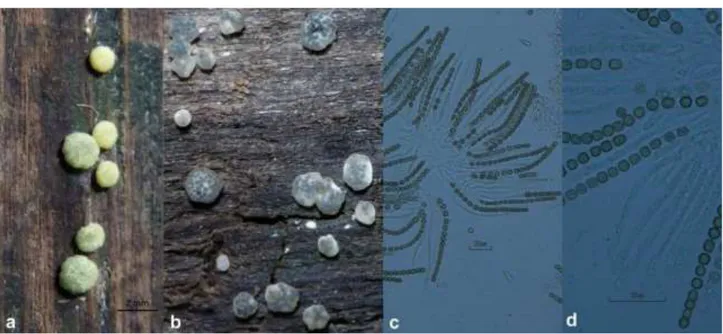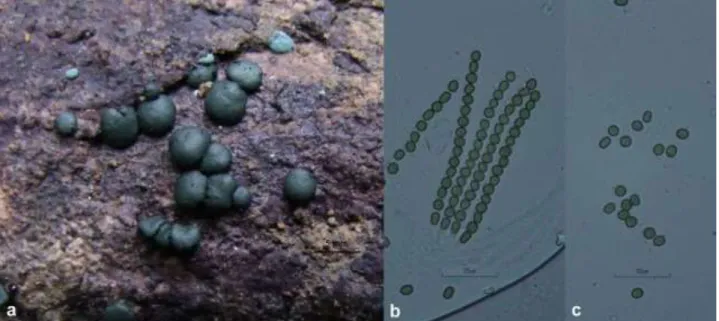www.biodicon.com Biological Diversity and Conservation
ISSN 1308-8084 Online; ISSN 1308-5301 Print 8/2 (2015) 117-121
Research note/Araştırma notu
Notes on Turkish Hypocrea
Yasin UZUN
1, Abdullah KAYA
*1, Ilgaz AKATA
2, Ali KELEŞ
3, Semiha YAKAR
11 1
Karamanoğlu Mehmetbey University, Kamil Özdağ Science Fac., Department of Biology, 70100, Karaman, Turkey
2Ankara University, Science Faculty, Department of Biology, 06100 Ankara, Turkey
3
Yüzüncü Yıl University, Education Faculty, Depatment of Science Education, 65080, Van, Turkey
Abstract
Four members of Hypocrea Fr. (Hypocrea alni Jaklitsch, Hypocrea gelatinosa (Tode) Fr., Hypocrea lixii Pat.,
Hypocrea nybergiana T. Ulvinen & H.L. Chamb), are given for the first time from Turkey. Including the previously
recorded Hypocrea leucopus (P. Karst.) H.L. Chamb, an identification key was prepared for Turkish Hypocrea. Short
descriptions of the newly recorded taxa are given together with the photographs related to their macro and
micromorphologies.
Key words: new record, Hypocrea, Turkey.
---
---
Türkiye Hypocrea’ları üzerine notlar
Özet
Dört Hypocrea Fr. (Hypocrea alni Jaklitsch, Hypocrea gelatinosa (Tode) Fr., Hypocrea lixii Pat., Hypocrea
nybergiana T. Ulvinen & H.L. Chamb) üyesi Türkiye’den ilk kez verilmiştir. Daha önceden kaydedilen Hypocrea
leucopus (P. Karst.) H.L. Chamb’u da dahil ederek, Türkiye Hypocrea’ları için bir teşhis anahtarı oluşturulmuştur. Yeni
kayıt olarak verilen taksonlara ait kısa betimleme, taksonların makro ve mikro morfolojilerine ait fotoğraflarıyla birlikte
verilmiştir.
Anahtar kelimeler: yeni kayıt, Hypocrea, Türkiye
1. Introduction
Hypocrea Fr. is a genus of the family Hypocreaceae within the order Hypocreales and its asexual forms are
mainly classified in the genus Trichoderma, while a few members belong to the other genera, such as Gliocladium
Corda or Stilbella Lindau (Jaklitsch, 2009).
Genus Hypocrea produce perithecia embedded in fleshy stromata forming by pseudoparenchymatous tissue or
highly compacted hyphae, two celled ascospores disarticulating at the septum within the asci of young samples, forming
16 ascospores in each ascus when mature (Jaklitsch et al., 2008; Jaclitsch, 2009).
The members of the genus usually occur on woody or herbaceous substrata, commonly in tropical or
subtropical regions and less frequently in arid, temperate or boreal zone (Chaverri and Samuels, 2003).
According to literature on Turkish macromycota (Sesli and Denchev, 2008, Solak et al., 2007; Akata, 2012),
only one member of Hypocrea (Hypocrea leucopus (P. Karst.) H.L. Chamb) has previously been reported from Turkey.
The aim of the present study is to make a contribution to Turkish mycobiota.
*

